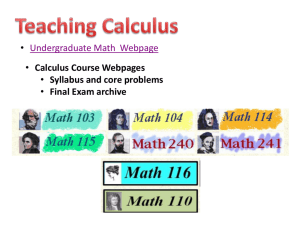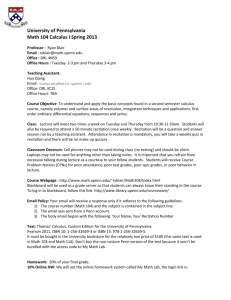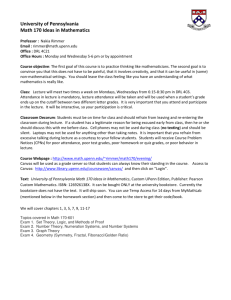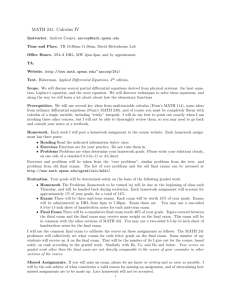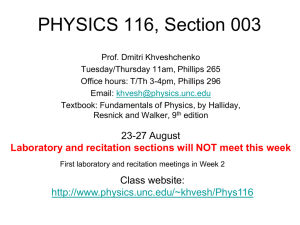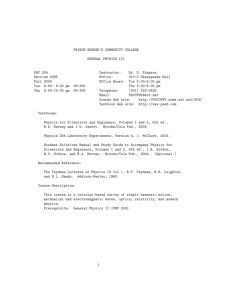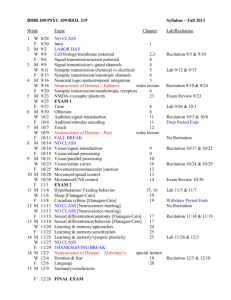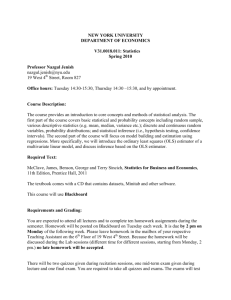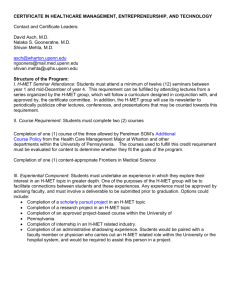University of Pennsylvania Math 104 Calculus I Spring
advertisement
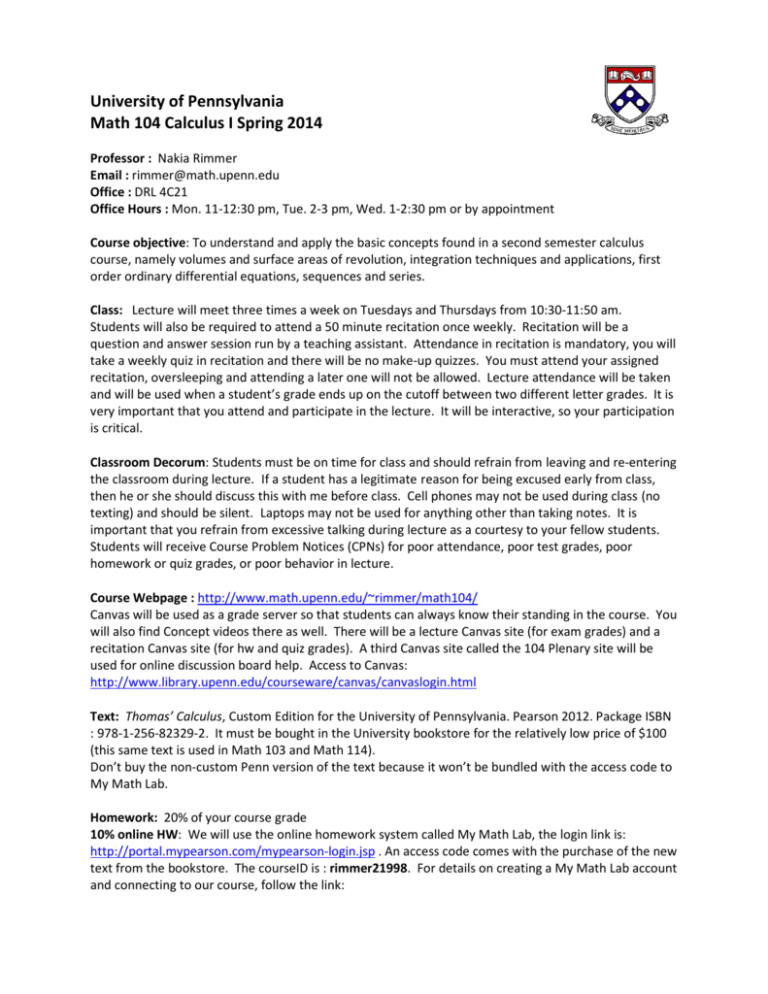
University of Pennsylvania Math 104 Calculus I Spring 2014 Professor : Nakia Rimmer Email : rimmer@math.upenn.edu Office : DRL 4C21 Office Hours : Mon. 11-12:30 pm, Tue. 2-3 pm, Wed. 1-2:30 pm or by appointment Course objective: To understand and apply the basic concepts found in a second semester calculus course, namely volumes and surface areas of revolution, integration techniques and applications, first order ordinary differential equations, sequences and series. Class: Lecture will meet three times a week on Tuesdays and Thursdays from 10:30-11:50 am. Students will also be required to attend a 50 minute recitation once weekly. Recitation will be a question and answer session run by a teaching assistant. Attendance in recitation is mandatory, you will take a weekly quiz in recitation and there will be no make-up quizzes. You must attend your assigned recitation, oversleeping and attending a later one will not be allowed. Lecture attendance will be taken and will be used when a student’s grade ends up on the cutoff between two different letter grades. It is very important that you attend and participate in the lecture. It will be interactive, so your participation is critical. Classroom Decorum: Students must be on time for class and should refrain from leaving and re-entering the classroom during lecture. If a student has a legitimate reason for being excused early from class, then he or she should discuss this with me before class. Cell phones may not be used during class (no texting) and should be silent. Laptops may not be used for anything other than taking notes. It is important that you refrain from excessive talking during lecture as a courtesy to your fellow students. Students will receive Course Problem Notices (CPNs) for poor attendance, poor test grades, poor homework or quiz grades, or poor behavior in lecture. Course Webpage : http://www.math.upenn.edu/~rimmer/math104/ Canvas will be used as a grade server so that students can always know their standing in the course. You will also find Concept videos there as well. There will be a lecture Canvas site (for exam grades) and a recitation Canvas site (for hw and quiz grades). A third Canvas site called the 104 Plenary site will be used for online discussion board help. Access to Canvas: http://www.library.upenn.edu/courseware/canvas/canvaslogin.html Text: Thomas’ Calculus, Custom Edition for the University of Pennsylvania. Pearson 2012. Package ISBN : 978-1-256-82329-2. It must be bought in the University bookstore for the relatively low price of $100 (this same text is used in Math 103 and Math 114). Don’t buy the non-custom Penn version of the text because it won’t be bundled with the access code to My Math Lab. Homework: 20% of your course grade 10% online HW: We will use the online homework system called My Math Lab, the login link is: http://portal.mypearson.com/mypearson-login.jsp . An access code comes with the purchase of the new text from the bookstore. The courseID is : rimmer21998. For details on creating a My Math Lab account and connecting to our course, follow the link: http://hans.math.upenn.edu/~rimmer/math104/homework/104mymathlabinstr.pdf . You will enter answers symbolically or numerically to problems that are very similar to the problems that are in the textbook. You will know immediately rather or not you got the question right and will have multiple times to enter in a solution. More often than not you will be given a hint to tell you what you might have done wrong. Some of the questions have multiple choices but the majority of them will be short answer. If you are having trouble with a problem you will be able to get help either by watching a video solution to a similar problem or by going through a step-by-step process to solve a similar problem. Problems will be chosen algorithmically (similar problems with different constants involved) so that few students are working on the same exact problem. Five percent of the total points available will be dropped. 10% Hand-in HW: Exam ready questions mostly taken from past final exams. Handed in weekly at the beginning of lecture on Tuesdays. It is considered on time if it is turned in within the first 15 minutes of class. Any homework turned in between the first 15 minutes and the end of class will be given half credit. It will be graded for completeness and correctness. The first one will be due on Tuesday Jan. 21st. You must make sure your recitation number is on the front page and that it is stapled. Failure to do this may result in a 0 grade. We will drop the lowest score. Quizzes: 10% of your course grade You will have weekly quizzes during the last 10-15 minutes of recitation over homework problems that were turned in the previous week. Think of the quizzes as mini-exams. The lowest quiz score will be dropped. There will be no make-up quizzes given. Quizzes will start in week 3 (1/27 - 1/31). Exams: 70 % of your course grade (40% Midterms, 25% Final, 5% Aux. Final) a) There will be five closed book in-class midterm exams. We will drop the lowest exam, the highest 4 scores will each count 10% towards your course grade. b) The final exam will be cumulative (covers all material), common (all 104 students take the same exam) and take place on Monday May 5th from 12-2 pm. It will count for 25 % of your final grade. c) There will be an Auxiliary Final Exam given during the last week of classes that will count for 5% of your course grade. This exam will cover pre-requisite material and meta-curriculum (skills such as: critical thinking, problem-solving, estimating) You are not allowed to use a calculator during the midterm and final exams but you can prepare and use one 8.5” by 11” sheet of paper (both sides) with handwritten notes of your choice. Since the exams are given in class, there will be absolutely no make-up exams. The final exam is used to set the curve at the end of the course, it determines the grade distribution. For example, after grading the final exam the Math 103 professors get together and decide what grade is considered an A, B, C, D, or F and then we tally the performance of each class to determine the distribution of each grade. Say for instance the distribution for my class is 32% A, 38% B, 25% C, 4% D and 1% F. This then becomes the course grade distribution, all students will be ranked from highest to lowest and the top 32% will be given some form of an A, the next 38% will be given some form of a B, and so on. The + or – cutoffs are determined by gaps in the distribution. No curve occurs until the end of the course so each midterm isn’t curved. I will give you an idea of your ranking after each midterm so that you can get a feel for where you stand in the course. No Calculator : Using a graphing calculator (or any type of calculator) is forbidden in this class. ADA Compliance : The Office of Student Disabilities Service (SDS) is part of the Weingarten Learning Resources Center. It provides accommodated exams and assistive technology (along with many other services) to students that self-identify in compliance with Section 504 of the Rehabilitation Act and the Americans with Disabilities Act. Please see their website ( http://www.vpul.upenn.edu/lrc/sds/current_students.php ) for more information. This most often takes the form of students that require extra time to take an exam taking the exam at the Weingarten Center. Code of Academic Integrity : The following is from the University’s website on academic integrity “Since the University is an academic community, its fundamental purpose is the pursuit of knowledge. Essential to the success of this educational mission is a commitment to the principles of academic integrity. Every member of the University community is responsible for upholding the highest standards of honesty at all times. Students, as members of the community, are also responsible for adhering to the principles and spirit of the following Code of Academic Integrity found here http://www.upenn.edu/academicintegrity/ai_codeofacademicintegrity.html If a student is unsure whether his action(s) constitute a violation of the Code of Academic Integrity, then it is that student’s responsibility to consult with the instructor to clarify any ambiguities. Get Help : Before it’s too late, please seek out help. One definition of too late is after you receive a low exam 1 score. The hardest part of the course is keeping up with the pace. Each lecture will cover about 1 to 1 ½ sections of material. If you miss a class and don't get a chance watch the archived video before the next class, then you will find it hard to catch up. Each section builds off of the previous one so waiting until the weekend to catch up might be impractical. 1. Ask lots of questions in recitation. Take advantage of recitation, don't just show up to take the quiz. 2. Instructor's office hours 3. TA's office hours From the Math Department: http://www.math.upenn.edu/ugrad/calc/help/schedule.html 4. Sunday Night Reviews (7-9pm each week) 5. Math/Maple Center (Mon. - Thurs. 6:30-9:30pm in various dorms) 6. Online Help (Discussion board on Blackboard's plenary site for your class monitored MTh 9pm - 1am) From the University: 7. Learning Resource Center, offered by the Weingarten Learning Resources Center, in Stouffer Commons, Suite 300, 3702 Spruce Street, Philadelphia PA 19104, tel: (215) 5739235 http://www.vpul.upenn.edu/lrc/ 8. The Tutoring Center : http://www.vpul.upenn.edu/tutoring/index.php 9. Math Department Approved Tutors : http://www.math.upenn.edu/ugrad/tutors.html Are you ready? : The class starts with integration so you need to have a good grasp of integration (what it is, how to use the Fundamental Theorem of Calculus, and how to use substitution) on day one. You also need to know how to find limits and derivatives. A good indication of readiness is a good performance on a Math 103 final exam. Archives of these exams can be found here: http://www.math.upenn.edu/ugrad/calc/m103/oldexams.html If you find that you are weak in some areas but are willing to work hard to overcome it, then I recommend staying in the course and giving it your all. A good place online to get some help in these areas can be found by following the link below: http://tutorial.math.lamar.edu/Classes/CalcI/CalcI.aspx You should plan on spending up to 10 hours per week outside of lecture and recitation in order to keep up with the pace of the course. If your schedule this semester won’t allow for this, then you should consider dropping the course. Topics covered in Math 104: Section Title 6.1 6.2 6.3 6.4 6.6 Volumes Using Cross Sections Volumes Using Cylindrical Shells Arc Length Areas of Surfaces of Revolution Moments and Centers of Mass 8.1 8.2 8.3 8.4 8.6 8.7 8.8 Integration by Parts Trigonometric Integrals Trigonometric Substitutions Integration by Partial Fractions Numerical Integration Improper Integrals Probability http://www.math.upenn.edu/ugrad/calc/m104/ThomasProb.pdf http://www.math.upenn.edu/ugrad/calc/m104/THOMAS_Probability_OddAns.pdf Section 9.1 7.2 9.2 9.3 10.1 10.2 10.3 10.4 10.5 10.6 10.7 10.8 10.9 10.10 Title Solutions, Slope Fields, and Euler's Method Exponential Change and Separable Differential Equations First Order Linear Equations Applications of First Order Ordinary Differential Equations Sequences Infinite Series The Integral Test Comparison Tests The Ratio and Root Tests Alternating Series, Absolute and Conditional Convergence Power Series Taylor and Maclaurin Series Convergence of Taylor Series The Binomial Series and Applications of Taylor Series Teaching Assistant : Alon Witztum Email: witztum@sas.upenn.edu Recitation : 231 REC M 8:00-8:50 AM DRLB 2C6 232 REC M 9:00-9:50 AM DRLB 2C6 233 REC W 8:00-8:50 AM DRLB 3C2 234 REC W 9:00-9:50 AM DRLB 3C2 Teaching Assistant : Chenkai Huang Email: hchenkai@seas.upenn.edu Recitation : 235 REC W 8:00-8:50 AM DRLB 2C8 236 REC W 9:00-9:50 AM DRLB 2C8 237 REC F 8:00-8:50 AM DRLB 2C8 238 REC F 9:00-9:50 AM DRLB 2C8
